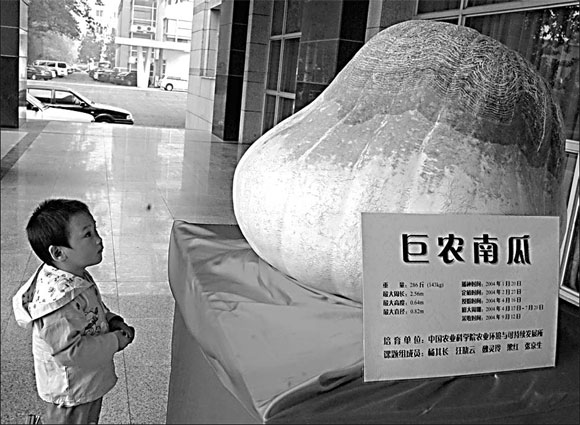Scientists engineer a bumper harvest
|
A child looks at a pumpkin, weighing 143 kilograms, on display at the Chinese Academy of Agricultural Sciences. Scientists and researchers from the academy took nine months to cultivate the giant pumpkin. Jiang Xin |
The nation is set for a bumper grain harvest this year. Sun Zhengcai, the agriculture minister, expects the total yield to hit 500 million tons. The last milestone was in 1984, when the grain harvest surpassed 400 million tons. It reached 300 million tons in 1978.
But as the harvest has grown, planting acreage has dwindled. From 121 million hectares in 1978, it dropped to 108 million hectares in 1984. By 2006 farming land had shrunk to 105 million hectares.
Meanwhile, the number of farmers has also steadily decreased, as about 200 million rural laborers flooded into cities to find jobs, according to the World Bank.
So who's responsible for the increased agricultural output?
Since 1977, China's economic development has gradually returned to a normal track after the 10-year "cultural revolution" (1966-76), and Chinese farmers have turned their attention to farming. This contributed to the high yield of 1978.
In the early 1980s, Chinese farmers were distributed plots of land through a household contract system. The reform rekindled their enthusiasm for farming and resulted in another steady increase in yield to 400 million tons of grain within six years.
Since the 1980s, scientists say they have played a bigger part.
"I believe science and technology have played an essential role in increasing the grain yield since the 1980s," said Zhai Huqu, president of the Chinese Academy of Agricultural Sciences.
Prior to the 50th anniversary of the establishment of the academy, Zhai said high-yield technologies helped feed China's growing population, which reached 1.31 billion in 2006. In 1978 the population was 975 million.
Zhai heads up a pool of 10,000 scientists. He said breakthroughs in hybrid rice, high-yield wheat, corn and cotton have provided a solution to the problem of feeding the nation.
Scientists have cultivated 15,000 new crops in the past 50 years. To mark the progress and anniversary, Zhai's academy will hold a celebration this Saturday.
Hybrid rice has been one of the most successful crops during this period. The hybrid rice cultivated in the early 1970s gradually boosted the country's rice output over the next 25 years by 400 million tons. That's equal to the country's entire food production in a single average year in the 1980s.
As well as hybrid rice plantations, China also made a breakthrough in wheat. The country plans to sow 33.5 million hectares of super-high-yield wheat by 2020, which could help increase harvests by 30 percent. It is expected that wheat harvests in main pilot areas could hit 10.45 tons per hectare. The national annual average yield was 4.25 tons in 2004.
Zhai believes China can become a powerhouse for international biotechnology within 15 years. He said the government should increase support for the research and application of biotechnology, mainly in the agriculture and health sectors.
As the government's leading advisor in the field, Zhai said it should encourage scientists and researchers to attempt to make breakthroughs using their own technology.
He said China is one of the world's heavyweights in biotechnology. "We are only behind the United States by five to 10 years in terms of overall research and development capacity."
However, China also faces obstacles in further increasing its crop yield. Shrinking arable land, the impact of climate change on agriculture, plant and animal disease prevention and food safety are high on his academy's research agenda.
Zhai said he is confident the challenges can be overcome. "The challenges are the impetus for research and scientific breakthroughs and I am confident our grain security and food safety can be sustained - even when our population reaches 1.6 billion in 2030," said Zhai.
Zhai said his confidence comes from local and foreign scientists and researchers. He said he has spent most of his time seeking talent since he became president of the agricultural academy. Now, more than 40 world-class scientists are working on rice, wheat, cotton, animal disease prevention and other sectors.
Zhang Lubiao, the academy's director of international cooperation, said many international research institutes have shown strong interest in moving their headquarters to China.
"Sooner or later, our achievements, coupled with theirs, will be benefiting our people and the rest of the world," Zhang said.
(China Daily 11/08/2007 page15)















